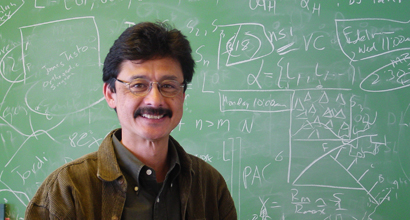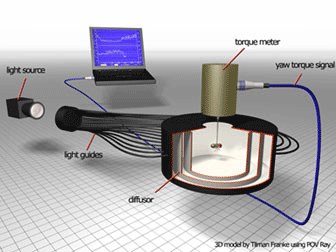
George Sugihara
Research Delves into Fruit Flies and Free Will
Methods originally developed for oceanic data were key for novel experiment
Reaching into the realm of philosophy, scientists at Scripps
Institution of Oceanography at UC San Diego have contributed to a
new study that addresses the free will of animals.
George Sugihara and Chih-hao Hsieh of Scripps stepped out of their
typical roles as marine scientists to join an international team
that used a combination of automated behavior recording and
mathematical analyses to show that free will and true spontaneity
could exist, at least in fruit flies.
The power to willfully behave differently in identical settings has
recently been questioned by neuroscientists. Previous research had
shown that flies do not buzz about aimlessly but forage according to
a sophisticated search strategy. The new research now suggests that
such strategies can arise spontaneously.
"Animals, especially insects, are usually seen as very complex
robots which only respond to external stimuli," said senior author
Bjšrn Brembs from the Free University Berlin. "They are said to be
input-output devices. When scientists observe animals responding
differently, even to the same external stimuli, they attribute this
variability to random errors in a complex brain."
Brembs and his colleagues developed a novel experiment in which the
flight paths of flies were monitored in a completely featureless
environment. The researchers tethered fruit flies in completely
uniform white surroundings and recorded their turning behavior. The
flies did not receive any visual cues from the environment and since
they were fixed in space, their turning attempts had no effect.

During the experiment, flies were suspended by a "torque meter"
device in a homogeneously white environment. The fly was
restriced in moving its body axis (i.e., flying stationary), but
could move its wings, legs and extend its proboscis. The forces
the fly generated as it turned its vertical body axis were
recorded.
Results of the experiments failed to yield any meaningful results
until they were processed with methods developed by Sugihara and
Hsieh to analyze marine ecology data and revealed the origin of the
fly's peculiar spontaneity. The researchers detected a non-linear
signature pattern in the fly behavior, one unique to systems whose
behavior can be attributed to their design, rather than external
forces.
The study was the first that showed that such variability cannot be
due to simple random events, nor to a simple stereotyped mechanism,
but are generated spontaneously and non-randomly by the brain.
"Our results address the middle ground between simple determinism
and randomness that is currently not well understood or
characterized," said Sugihara. "We speculate that if free will
exists, it is in this middle ground. This humble experiment
addresses the two extreme counter arguments against the existence of
free will: That behavior is simply deterministic and that behavior
is random. Our measurements show it is neither of these
possibilities, which leaves the question an open one."
—Mario C. Aguilera
|